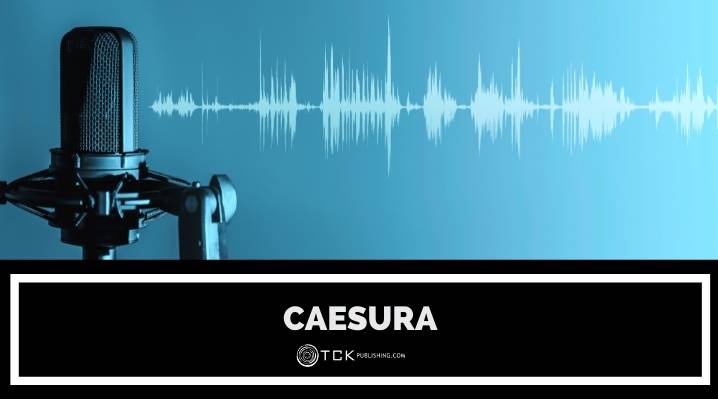
When we speak, there is a rhythm of pauses between the natural breaks in our sentences. These pauses also occur in poetry, and are called caesura (suh·zur·uh).
These rhythmical pauses often occur in the middle of a poetic line or sentence but are also found at the beginning or end of a line. They are often expressed with a tick (✓), a comma (,), or two parallel lines that are either upright (||) or slashed (//).
It’s not necessary to use these symbols though, as a caesura is simply part of the way a reader naturally reads a poetic line.
Is Caesura a Language Technique?
You don’t need to learn how to create caesura because these “breaks” are a natural part of your speech patterns, and in extension, how you read and write poetry. You can definitely create artificial breaks, but there are no real techniques or rules for doing so; it just depends on why you’re using it.
You can use them to draw attention to a certain word or line. Sometimes a pause even helps your readers reflect on what you’ve just said. But mostly, you use pauses (both in speech and poetry) to build up tension and emphasize your next words.
Types of Caesura
Here are the two main types of caesura, classified by the stress of their preceding syllable:
1. Masculine
A caesura is defined as masculine if it occurs after a stressed syllable, often creating a staccato effect. Take a look at this excerpt from Mother and Poet by Elizabeth Barrett. You can listen to a reading of the poem to better identify the caesura.
What art can a woman be good at? || Oh, vain!
What art is she good at, || but hurting her breast
With the milk-teeth of babes, || and a smile at the pain?
Ah boys, how you hurt! || you were strong as you pressed,
And I proud, || by that test.
Here you can see how punctuation often influences the stress of a syllable. For example, the word “hurt” in the fourth line is punctuated with an exclamation point, turning it into a stressed syllable. The following pause is then a masculine caesura.
2. Feminine
A caesura becomes feminine when it occurs after an unstressed syllable. This creates a softer and less abrupt flow in the poem. See William Shakespeare’s The Winter’s Tale as an example. Listen to the it here.
It is for you we speak, || not for ourselves:
You are abused || and by some putter-on
That will be damn’d for’t; || would I knew the villain,
I would land-damn him. || Be she honour-flaw’d,
I have three daughters; || the eldest is eleven
Shakespeare demonstrates perfect feminine caesuras here. Take the last line, for example. The “daugh” in daughters is stressed, but the “ters” is not, so the pause that follows is a feminine caesura.
Feminine caesura is further divided into two subdivisions:
- An epic caesura follows an unstressed syllable that is within an iambic pentameter (a line consisting of 5 sets of two beats each, the first unstressed, and the second stressed). A famous example is from Shakespeare’s Macbeth: “but how of Cawdor? || The Thane of Cawdor lives”.
- A lyric caesura follows a syllable that the line naturally requires to be unstressed. An example is from Housman’s The Welsh Marshes: “they cease not fighting ∥ east and west”
Types of Caesura by Position
Here are three types of caesura, classified depending on their location on a poetic line:
1. Initial
An initial caesura occurs at the beginning of a poetic line. Take the beginning of Shakespeare’s Hamlet’s famous soliloquy as an example:
To be, or not to be — that is the question:
The comma acts as a signal for the reader to pause before continuing with the line.
2. Medial
A medial caesura occurs at the middle of a poetic line. Take another look at Hamlet’s soliloquy:
To be, or not to be — that is the question:
The medial caesura here is the dash after the word “be,” which also signals the reader to pause before finishing the line.
3. Terminal
A terminal caesura occurs at the end of a poetic line. Check out a line from Emily Dickinson’s I’m Nobody! Who Are You?:
Then there’s a pair of us — don’t tell!
The dash here forces the reader to pause, which also creates the staccato effect that masculine caesuras are characterized by.
Caesura in Literature
Caesuras have been in use since classical times, although their usage has evolved from simply being words at the end of a metrical foot. In Germanic and Old English poetry, they were mostly used to divide a line into two halves. In modern times, they simply mean a pause within a poetic line.
Here are a few famous poems that demonstrate the use of caesura:
1. Beowulf by Unknown
A ring-whorled prow rode in the harbour,
Ice-clad, || outbound, || a craft for a prince.
They stretched their beloved lord in his boat,
Laid out by the mast, || amidships,
The great ring-giver. || Far-fetched treasures
Were piled upon him, || and precious gear.
I never heard before of a ship so well furbished
With battle tackle, || bladed weapons
And coats of mail. || The massed treasure
Was loaded on top of him: || it would travel far
On out into the ocean’s sway.
Beowulf is one of the oldest surviving poems written in Old English. You can see how people of that era used caesuras to divide lines into two halves.
Listen to the poem here.
2. Ozymandias by Percy Bysshe Shelly
Who said—”Two vast and trunkless legs of stone
Stand in the desert … || Near them, || on the sand …
My name is Ozymandias, || King of Kings; ||
Look on my Works, || ye Mighty, || and despair!
Nothing beside remains. || Round the decay …
Shelley craftily uses caesuras here to create a more interesting rhythm within his poem. The multiple caesuras in many of the lines also serve to emphasize each of Ozymandia’s accomplishments.
Listen to the poem here.
3. The Raven by Edgar Allan Poe
Once upon a midnight dreary, || while I pondered weak and weary,
Over many a quaint and curious || volume of forgotten lore,
While I nodded, nearly napping, || suddenly there came a tapping,
As of someone gently rapping, || rapping at my chamber door.
`’Tis some visitor,’ || I muttered, || `tapping at my chamber door –
Only this, and nothing more.’ – Edgar Allen Poe’s
Notice how Poe’s use of caesuras further dramatize the situation and enforce the poem’s imagery. That, combined with internal rhymes (weary/dreary; napping/tapping) makes us read the poem in ways we usually wouldn’t do. Normally, we wouldn’t pause between “curious” and “volume” in the second line, but the structure of the poem encourages us to do so.
Listen to the poem here.
Why Do Writers Use Caesuras?
Caesuras are largely used to avoid monotony in your works. Because line breaks serve as the natural pauses of a poem (regardless of punctuation), a poem’s rhythm can seem repetitive.
By using caesuras, you can vary these rhythms to create a more dynamic read or use them to emphasize words and create a more emotional effect. Sometimes, you can also use caesuras purely for aesthetics.
Without them, you have less freedom in using complex sentences or punctuation in a poem. This limits your ability to convey your meaning to your readers.
What are your favorite poems that use caesura? Share them in the comments below!
If you enjoyed this post, then you might also like:
- 17 of the Most Common Literary Devices Every Reader and Writer Should Know
- How to Analyze a Poem: 8 Tips for Understanding Poetry
- Introduction to Metaphors: Poetry in Motion
- What Is Half Rhyme? Definition and Examples from Poetry

Cole is a blog writer and aspiring novelist. He has a degree in Communications and is an advocate of media and information literacy and responsible media practices. Aside from his interest in technology, crafts, and food, he’s also your typical science fiction and fantasy junkie, spending most of his free time reading through an ever-growing to-be-read list. It’s either that or procrastinating over actually writing his book. Wish him luck!
